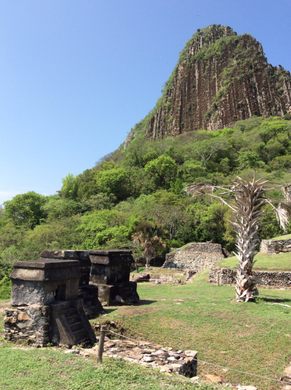AO Edited
Quiahuiztlán
The site where the Spanish first landed in Mexico was once a thriving Mesoamerican city.
Driving north from the port city of Veracruz, a rock formation, known as Cerro de los Metates, rises dramatically above the level coastal plain of the Gulf lowlands. The monolithic mountain dominates the surrounding landscape. A steep ascent on a rutted dirt road leads to the base of the landmark’s vertical rock walls, and an ancient necropolis known as Quiahuiztlán. Here, during the Postclassic period (around 1100-1519), the Totonac inhabitants of the region erected 78 stone tombs, approximately four feet high, resembling miniature temples. Their contents originally contained human skeletal remains, polychrome pottery, and the metates (or grinding stones) that give Cerro de los Metates its name.
These houses of the dead are scattered throughout three areas of leveled, elevated ground, with some perched like sentries towards the Gulf of Mexico. The archaeological site offers spectacular views of the turquoise waters of Villa Rica, including the beach where Hernán Cortes landed in 1519. Villa Rica was the first European settlement in Mexico, and Quiahuiztlán is mentioned in various 16th-century Spanish chronicles recounting the Spanish-Aztec War.
While the tombs are the most unique feature here, two pyramids, a Mesoamerican ballcourt, defensive walls, plazas, stone steps, terraces, and other structural remains are scattered throughout the site. Paths lead through dense tropical foliage. Technical climbing routes entice climbers to scale one of several routes ascending the rock face. Chosen for its strategic position, the city was established around 800. By 1500, Quiahuiztlán was a thriving pre-Hispanic city of 16,000 inhabitants.
After exploring the site, consider lunch or a swim at nearby Villa Rica, one of the most beautiful and least discovered beaches in Mexico.
Know Before You Go
Quiahuiztlán is located off Highway 180, the main coastal route. From the port city of Veracruz drive north about 34 miles (62 km). After the village of El Farallón, you’ll see a left-hand turn up a steep dirt road, which will bring you to the archaeological zone.
There are hourly buses between Veracruz and Palma Sola (approximately 65 minutes). At Palma Sola, you can take a taxi to Quiahuitztlan (15 minute ride). Traveling south by bus from Nautla to Palma Sola takes 55 minutes. From Xalapa, buses leave every 15 minutes for José Cardel (65 minutes) where you’ll want to change to the bus to Palma Sola (37 minutes; buses leave hourly).
Quiahuiztlán is on the main coastal route between Poza Rica (near El Tajín) and Veracruz, and close to the archaeological site of Cempoala, the former Totonac capital.
The site is open from 9am-5 pm daily, administered by INAH, the governing archaeological body for Mexico.
Community Contributors
Added by
Edited by
Plan Your Trip
The Atlas Obscura Podcast is Back!






















![Römerstadt Carnuntum [Roman City Carnuntum]](https://img.atlasobscura.com/lJwz_PppknPO9xNJQ9B_K-c0MK8DHICI79iGIf-ybVI/rs:fill:600:400:1/g:ce/c:3989:2659:nowe:5:308/q:81/sm:1/scp:1/ar:1/aHR0cHM6Ly9hdGxh/cy1kZXYuczMuYW1h/em9uYXdzLmNvbS91/cGxvYWRzL3BsYWNl/X2ltYWdlcy8wYjVm/MTMyZS1lYTJkLTQ0/ZDktODk3Ni1kNjJj/NWM4ZGFmYTliODQw/MzM2Y2ZlMzVjN2Fi/OTVfMTQ2NzI0MjYz/MDFfZWFlMjQ5MjYz/YV9vLmpwZw.jpg)


Follow us on Twitter to get the latest on the world's hidden wonders.
Like us on Facebook to get the latest on the world's hidden wonders.
Follow us on Twitter Like us on Facebook